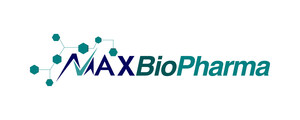MAX BioPharma Announces Key Update to its Liver Fibrosis Program Showing Efficacy of an Oxysterol Lead Drug Candidate in Inhibiting NASH in a Humanized Mouse Model
MAX BioPharma is Pursuing Strategic Partnerships and Series A Financing
LOS ANGELES, March 3, 2020 /PRNewswire/ -- MAX BioPharma, Inc. (www.maxbiopharma.com) recently published an article describing its anti-tumorigenic oxysterol lead compound, Oxy210, in the peer-reviewed journal, Cells. (https://www.mdpi.com/2073-4409/8/10/1297/pdf). Oxy210 is derived from the Company's Oxysterol Therapeutics® platform of proprietary oxysterols. Oxy210 was shown to inhibit two key cellular pathways, Hedgehog and transforming growth factor beta (TGFb), which play important roles not only in cancer but also in driving pathologic fibrosis in a number of organs including liver, lung and kidney. Oxy210 has unique mechanisms of action compared to other Hedgehog and TGFb signaling inhibitors that are commercially available or under clinical development. This new drug candidate is orally bioavailable, has favorable pharmacokinetic and safety profiles, is scalable, and was found to inhibit activation and pro-fibrotic activities of human liver stellate cells that drive fibrosis.
In a recent 16-week study conducted at UCLA under the direction of Drs. Jake Lusis and Simon Hui, Oxy210 was found to significantly inhibit development of fibrosis in a humanized mouse model of non-alcoholic steatohepatitis (NASH) that involves progressive inflammation, fat deposition and fibrosis in the livers of these mice. The inhibition of fibrosis involved inhibited expression of TGFb, NLRP3 inflammasome, and inflammatory cytokines: interleukin-6 (IL-6), tumor necrosis alpha (TNF-a), and monocyte chemotactic protein 1 (MCP-1) in the liver and plasma of mice that consumed Oxy210 incorporated in their food. Moreover, Oxy210 inhibited lipid deposition, including total cholesterol, unesterified cholesterol, cholesterol ester, and phospholipids in the livers of the hyperlipidemic mice.
"There is an urgent need for therapies to treat fatty liver disease, and I find the results of our studies with MAX BioPharma quite exciting," states Dr. Lusis, Principal Investigator and Professor of Medicine, Human Genetics, Microbiology, Immunology & Molecular Genetics at UCLA.
"Our humanized hyperlipidemia mouse model of NASH reflects the natural history of non-alcoholic fatty liver disease (NAFLD) progression in humans and reproduces the salient features of human NASH. Attenuation of hepatic fibrosis and inflammation by Oxy210 suggest that it could be a promising therapeutic for human NASH," explains Dr. Hui, Project Scientist and Co-Principal Investigator at UCLA.
"Evidence that the Hedgehog-TGFb inhibitor, Oxy210, improves liver inflammation and fibrosis in the mouse model of NASH is encouraging given growing evidence that these signaling pathways critically control liver repair and are dysregulated in patients with NASH, cirrhosis and primary liver cancer," states Dr. Anna Mae Diehl, Florence McAlister Distinguished Professor of Medicine at Duke University.
MAX Biopharma is currently optimizing oral dosing with Oxy210 and performing pre-clinical studies required by the FDA for clinical development and commercialization, and is seeking strategic partnerships with biotechnology and pharmaceutical companies that have the expertise and resources to further the development of oxysterols towards FDA approval and commercialization. In addition, MAX BioPharma is in the process of raising a series A financing round to support the advancement of its therapeutic development programs. "We are very excited and hopeful that our efforts will result in an effective and safe therapy for NASH that will significantly improve the lives of those affected by this currently incurable disease" says Dr. Farhad Parhami, Founder, President and CEO of MAX BioPharma.
About MAX BioPharma, Inc.
MAX BioPharma is a privately-held preclinical stage California-based biopharmaceutical company developing novel small molecule lipids as drug candidates for intervention in debilitating and fatal human diseases. The company will be a leader in a new field of Oxysterol Therapeutics® by leveraging a robust and growing intellectual property portfolio that will lead to treatments for numerous indications. MAX BioPharma's first success based on small molecule lipids has contributed to the discovery of novel osteogenic oxysterol compounds that target multipotent mesenchymal cells, including mesenchymal stem cells, to induce the formation of bone-forming osteoblasts and bone. The company is translating this technology into the next generation of therapeutic agents for stimulation of bone formation, locally and systemically, in indications such as spinal fusion, non-union fractures, and osteoporosis. MAX BioPharma is also pursuing the development of small molecule oxysterols that function as anti-tumorigenic Hedgehog and TGFb pathway antagonists that will be more effective than currently known antagonists in treating a variety of cancers, including lung and pancreatic cancer, and hematologic malignancies, as well as fibrotic diseases of liver, lung, and kidney among others. For more information please visit us at www.maxbiopharma.com
Media Contact: Farhad Parhami
[email protected]
SOURCE MAX BioPharma

Related Links
WANT YOUR COMPANY'S NEWS FEATURED ON PRNEWSWIRE.COM?
Newsrooms &
Influencers
Digital Media
Outlets
Journalists
Opted In





Share this article